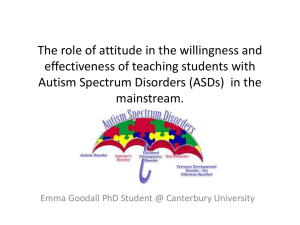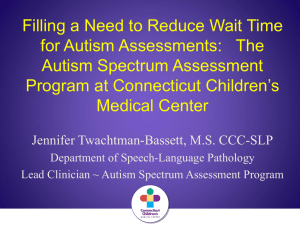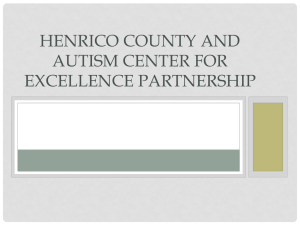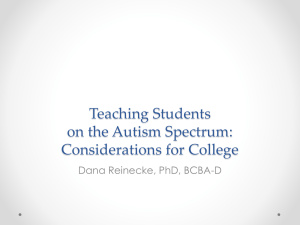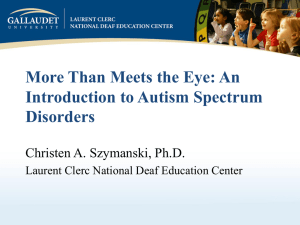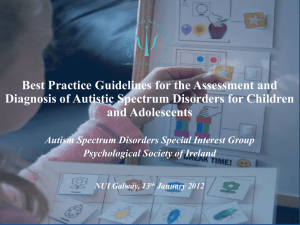Half of Virginia`s Children with Autism Spectrum Disorders
advertisement
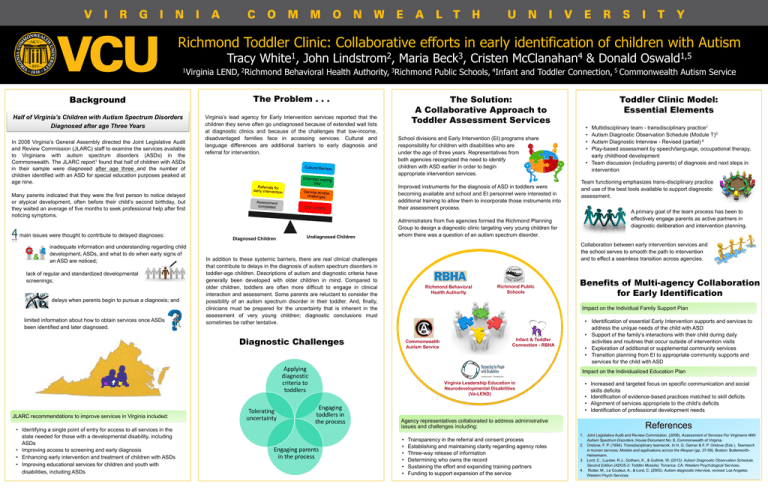
Richmond Toddler Clinic: Collaborative efforts in early identification of children with Autism Tracy 1Virginia 1 White , John 2 Lindstrom , The Problem . . . Half of Virginia’s Children with Autism Spectrum Disorders Diagnosed after age Three Years Virginia’s lead agency for Early Intervention services reported that the children they serve often go undiagnosed because of extended wait lists at diagnostic clinics and because of the challenges that low-income, disadvantaged families face in accessing services. Cultural and language differences are additional barriers to early diagnosis and referral for intervention. inadequate information and understanding regarding child development, ASDs, and what to do when early signs of an ASD are noticed; lack of regular and standardized developmental screenings; delays when parents begin to pursue a diagnosis; and limited information about how to obtain services once ASDs have been identified and later diagnosed. The Solution: A Collaborative Approach to Toddler Assessment Services School divisions and Early Intervention (EI) programs share responsibility for children with disabilities who are under the age of three years. Representatives from both agencies recognized the need to identify children with ASD earlier in order to begin appropriate intervention services. Improved instruments for the diagnosis of ASD in toddlers were becoming available and school and EI personnel were interested in additional training to allow them to incorporate those instruments into their assessment process. Many parents indicated that they were the first person to notice delayed or atypical development, often before their child’s second birthday, but they waited an average of five months to seek professional help after first noticing symptoms. 4 main issues were thought to contribute to delayed diagnoses: Diagnosed Children Undiagnosed Children Administrators from five agencies formed the Richmond Planning Group to design a diagnostic clinic targeting very young children for whom there was a question of an autism spectrum disorder. In addition to these systemic barriers, there are real clinical challenges that contribute to delays in the diagnosis of autism spectrum disorders in toddler-age children. Descriptions of autism and diagnostic criteria have generally been developed with older children in mind. Compared to older children, toddlers are often more difficult to engage in clinical interaction and assessment. Some parents are reluctant to consider the possibility of an autism spectrum disorder in their toddler. And, finally, clinicians must be prepared for the uncertainty that is inherent in the assessment of very young children; diagnostic conclusions must sometimes be rather tentative. Richmond Behavioral Health Authority Tolerating uncertainty Toddler Clinic Model: Essential Elements • • • • Multidisciplinary team - transdisciplinary practice2 Autism Diagnostic Observation Schedule (Module T)3 Autism Diagnostic Interview - Revised (partial) 4 Play-based assessment by speech/language, occupational therapy, early childhood development • Team discussion (including parents) of diagnosis and next steps in intervention Team functioning emphasizes trans-disciplinary practice and use of the best tools available to support diagnostic assessment. A primary goal of the team process has been to effectively engage parents as active partners in diagnostic deliberation and intervention planning. Richmond Public Schools Benefits of Multi-agency Collaboration for Early Identification Impact on the Individual Family Support Plan Commonwealth Autism Service Applying diagnostic criteria to toddlers • Identifying a single point of entry for access to all services in the state needed for those with a developmental disability, including ASDs • Improving access to screening and early diagnosis • Enhancing early intervention and treatment of children with ASDs • Improving educational services for children and youth with disabilities, including ASDs & Donald 1,5 Oswald Collaboration between early intervention services and the school serves to smooth the path to intervention and to effect a seamless transition across agencies. Diagnostic Challenges JLARC recommendations to improve services in Virginia included: Cristen 4 McClanahan LEND, 2Richmond Behavioral Health Authority, 3Richmond Public Schools, 4Infant and Toddler Connection, 5 Commonwealth Autism Service Background In 2008 Virginia’s General Assembly directed the Joint Legislative Audit and Review Commission (JLARC) staff to examine the services available to Virginians with autism spectrum disorders (ASDs) in the Commonwealth. The JLARC report1 found that half of children with ASDs in their sample were diagnosed after age three and the number of children identified with an ASD for special education purposes peaked at age nine. Maria 3 Beck , Infant & Toddler Connection - RBHA • Identification of essential Early Intervention supports and services to address the unique needs of the child with ASD • Support of the family’s interactions with their child during daily activities and routines that occur outside of intervention visits • Exploration of additional or supplemental community services • Transition planning from EI to appropriate community supports and services for the child with ASD Impact on the Individualized Education Plan Virginia Leadership Education in Neurodevelopmental Disabilities (Va-LEND) Engaging toddlers in the process Engaging parents in the process Agency representatives collaborated to address administrative issues and challenges including: • • • • • • Transparency in the referral and consent process Establishing and maintaining clarity regarding agency roles Three-way release of information Determining who owns the record Sustaining the effort and expanding training partners Funding to support expansion of the service • Increased and targeted focus on specific communication and social skills deficits • Identification of evidence-based practices matched to skill deficits • Alignment of services appropriate to the child’s deficits • Identification of professional development needs References 1. Joint Legislative Audit and Review Commission. (2009). Assessment of Services For Virginians With Autism Spectrum Disorders. House Document No. 8, Commonwealth of Virginia. 2. Orelove, F. P. (1994). Transdisciplinary teamwork. In H. G. Garner & F. P. Orelove (Eds.), Teamwork in human services: Models and applications across the lifespan (pp. 37-59). Boston: ButterworthHeinemann. 3. Lord, C., Luyster, R.J., Gotham, K., & Guthrie, W. (2012). Autism Diagnostic Observation Schedule, Second Edition (ADOS-2: Toddler Module). Torrance, CA: Western Psychological Services. 4. Rutter, M., Le Couteur, A., & Lord, C. (2003). Autism diagnostic interview, revised. Los Angeles: Western Psych Services.



